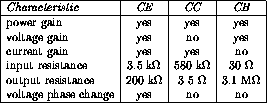In any transistor circuit design you must supply a DC bias current and
voltage to operate in the linear region of the characteristic curve.
The DC operating point is defined by the values of ![]() and
and ![]() .
You must also obtain the proper AC operation.
.
You must also obtain the proper AC operation.
The transistor is a three-terminal device that we will use to form a four-terminal circuit. Small voltage changes in the base-emitter junction will produce large current changes in the collector and emitter, whereas small changes in the collector-emitter voltage have little effect on the base. The result is that the base is always part of the input to a four-terminal network. There are three common configurations: common emitter (CE), common collector (CC) and common base (CB), as shown in figure 5.5.

Figure 5.5: Transistor basic circuit configurations: a)
common emitter (CE), b) common collector (CC) and c) common base (CB).
The operating characteristics of the different circuit configurations are shown in table 5.1.

Table 5.1: Operating characteristics of different
transistor circuit configurations.
Narippawaj Ngernvijit